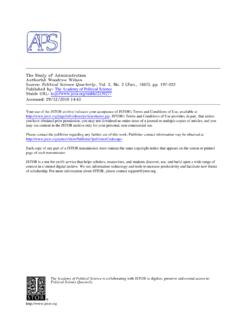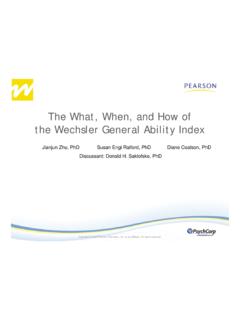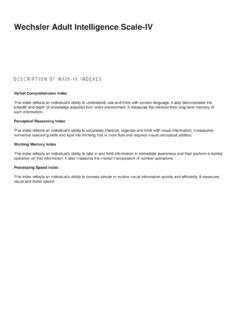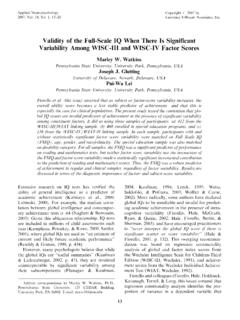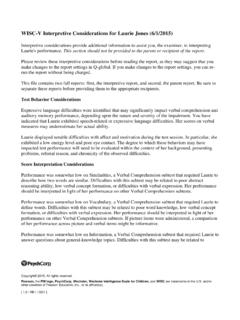Transcription of Wechsler Intelligence Scale for Children - Indiana University
1 Wechsler Intelligence Scale for Children -IV Conceptual and Interpretive Guide Overview The Wechsler Intelligence scales were developed by Dr. David Wechsler , a clinical psychologist with Bellevue Hospital. His initial test, the Wechsler -Bellevue Intelligence Scale , was published in 1939 and was designed to measure intellectual performance by adults. Wechsler constructed the WBIS based on his observation that, at the time, existing Intelligence tests for adults were merely adaptations of tests for Children and had little face validity for older age groups. Since 1939, three scales have been developed and subsequently revised, to measure intellectual functioning of Children and adults. The Wechsler Adult Intelligence Scale -III (WAIS-III) is intended for use with adults. The Wechsler Intelligence Scale for Children -IV (WISC-IV) is designed for Children ages 6 - 16, while the Wechsler Preschool and Primary Scale of Intelligence -III (WPPSI-III) is designed for Children age 4 - 6 1/2 years.
2 Definition of Intelligence Wechsler defined Intelligence as an individual's ability to adapt and constructively solve problems in the environment. It is significant that Wechsler viewed Intelligence not in terms of capacity, but rather, in terms of performance. That is, the Wechsler scales are not purported to measure one's quantity of Intelligence , but instead measures one's intellectual performance. The rationale for conceptualizing Intelligence as a performance variable is that it does not really matter how much Intelligence one has, in order to adapt to the environment. What matters is how well one uses his/her Intelligence . Also, since intellectual capacity cannot be seen nor its existence concretely verified, it cannot be reliably measured. Performance can be measured and, thus, should be the focus of the test. Although Wechsler has written much to support this position, other Intelligence developers have taken essentially the same position regarding the nature of Intelligence .
3 Most major Intelligence tests, such as the Stanford-Binet, the Peabody Picture Vocabulary Test, and the Guilford Intelligence Scales, are grounded in the view of Intelligence tests as performance measures. The Wechsler scales, like the Binet and other tests, measure intellectual performance as a multidimensional construct. This means that, rather than conceptualizing Intelligence as a single characteristic, the tests contain numerous scales assessing qualitatively different types of intellectual functioning. The notion of multidimensional Intelligence is certainly not new in cognitive psychology; in the 1920s, Thurstone and Spearman viewed Intelligence as consisting of several components. However, in contrast to earlier multidimensional views, current Intelligence tests view Intelligence not as specific abilities emanating from a "general" intellectual capacity ( , general S with many specific "s" factors), but as different types of Intelligence , each type being of equal adaptive importance.
4 Credibility of WISC-IV Results How do we know the WISC-IV is a reliable measure of Intelligence ? Standardized Intelligence tests are constructed according to strict guidelines to ensure reliability and validity. Reliability refers to the consistency of a measure over time and across the content ( , the item responses) of the test. A test is considered reliable if we are able to get the same/similar result repeatedly. For example, if a test is designed to measure Intelligence , two of the same form of test (say, Part A and Part B) should bear very close results when administered to a subject. Having said that, it is almost impossible to calculate reliability accurately, but there several different ways to estimate reliability (there are a lot of internet resources on this subject). In this case, the WISC-IV is believed to be a reliable measure of Intelligence .
5 A test is considered valid if the scores accurately and consistently describe a child's intellectual performance and adaptation in day to day life. Among other reasons, testing is done when one has some concerns about a child's learning needs and wants to determine the child's learning potential and placement in certain programs (usually gifted programs). Apart from providing IQ scores, the WISC-IV also provides essential information and critical clinical insights into a child's cognitive functioning. It also integrates current conceptualizations and recent research to provide the most essential information about a child's strengths and weaknesses. There is a lot of input from practitioners and experts in the field. Over time and several reviews, the WISC-IV (which is an update of the WISC-III) is concluded to represent significant advances in the understanding of cognitive abilities.
6 Administered in a time period between 65 and 80 minutes, the WISC-IV contains 10 core subtests and 5 additional subtests. These are summed to four indexes (the Verbal Comprehension Index, the Perceptual Reasoning Index, the Working Memory Index and the Processing Speed Index) and one Full Scale IQ (FSIQ) which ranges from lowest 40 to highest 160 points. Subtests are given for additional examination of processing abilities. The age range for this test is between 6 years and 16 years 11 months. In terms of difference in scores, an individual who has taken the WISC-III, then retested with the WISC-IV may show a 5 point drop in FSIQ. This is due to new aspects of the test, and the novelty of some of the new items and subtests. The following are the four main indexes of the WISC-IV and what they measure: Verbal Comprehension Index (VCI) Measure: Verbal concept formation.
7 Tests include Similarities, Vocabulary, and Comprehension. Optional tests are Information and Word Reasoning. Assesses Children 's ability to listen to a question, draw upon learned information from both formal and informal education, reason through an answer, and express their thoughts aloud. It can tap preferences for verbal information, a difficulty with novel and unexpected situations, or a desire for more time to process information rather than decide "on the spot." Perceptual Reasoning Index (PRI) Measure: Non-verbal and fluid reasoning. Tests include Block Design, Picture Concepts, and Matrix Reasoning. Optional test is Picture Completion. It assesses Children 's ability to examine a problem, draw upon visual-motor and visual-spatial skills, organize their thoughts, create solutions, and then test them. It can also tap preferences for visual information, comfort with novel and unexpected situations, or a preference to learn by doing.
8 Working Memory Index (WMI) Measure: Working memory. Tests include Digit Span and Letter-Number Sequencing. Optional test is Arithmetic. It assesses Children 's ability to memorize new information, hold it in short-term memory, concentrate, and manipulate that information to produce some result or reasoning processes. It is important in higher-order thinking, learning, and achievement. It can tap concentration, planning ability, cognitive flexibility, and sequencing skill, but is sensitive to anxiety too. It is an important component of learning and achievement, and ability to work effectively with ideas as they are presented in classroom Processing Speed Index (PSI) Measure: Speed of Information Processing. Tests include Coding and Symbol Search. Optional test is Cancellation. It assesses Children 's abilities to focus attention and quickly scan, discriminate between, and sequentially order visual information.
9 It requires persistence and planning ability, but is sensitive to motivation, difficulty working under a time pressure, and motor coordination too. Cultural factors seem to have little impact on it. It is related to reading performance and development too. It is related to Working Memory in that increased processing speed can decrease the amount of information a child must "hold" in working memory. On the other hand, lower processing speed can impair the effectiveness of working memory by requiring the child to "hold" in working memory more information than the child can effectively process at a given time. As an analogy, one can think of the thinking brain like the front entrance to a Victorian style home. There is a porch, front door, a foyer and, of course, the rest of the house. Guests (information) knock at the door and "stand on the porch"( , teacher presents concepts).
10 The host ( , the brain) lets the "guest" come into the foyer ( , brain perceives the information and registers that it is there). The host helps the guests take off coat and boots ( , the brain organizes and clarifies the information for storage), and brings them into the house ( encodes the information into longer term memory). If the host takes too long to perform "hosts tasks" and get the guests into the living room, some guests may biome impatient and leave ( , some information is not encoded). Based on new neurological models of cognitive functioning, there have a number of improvements in the WISC-IV, namely: *Betterment in assessing fluid reasoning *Less reliance on speed for PRI - better differentiates PRI from PSI * Better assessment of WM through changes made to one test and addition of a new subtest *Improved subtest reliabilities, floors and ceilings from WISC-III *Enhanced clinical validity, improved reliabilities and validities (updating of norms) *Updated art *Less cultural, SES or regional bias *The integrated version that allows some multiple choice testing of Children to see what they know but can not express WISC-IV Subtests (see also ) Word Reasoning - measures reasoning with verbal material; child identifies underlying concept given successive clues.


